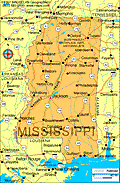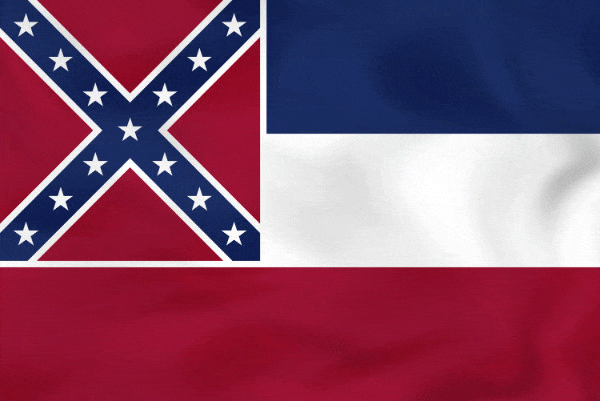M-I-S-S-I-S-S-I-P-P-I
Spelling out Mississippi used to be a jump rope game on the school playground.

The Mississippi State Flag was appointed by legislative action February 7, 1894, and provided that the flag reported by the committee should become the official flag. The committee recommended for the flag "one with width two-thirds of its length; with the union square, in width two-thirds of the width of the flag; the ground of the union to be red and a broad blue saltier thereon, bordered with white and emblazoned with thirteen (13) mullets or five-pointed stars, corresponding with the number of the original States of the Union; the field to be divided into three bars of equal width, the upper one blue, the center one white, and the lower one extending the whole length of the flag.
Mississippi Facts and Trivia
Thanks to: Ron Collins, Greg Maxedon, Source: 'Mississippi', published by the office of the Secretary of State


Capital: Jackson
State abbreviation/Postal code: Miss./MS
U.S. Representatives: 4
Organized as territory: April 7, 1798
Entered Union (rank): Dec. 10, 1817 (20)
Present constitution adopted: 1890
Motto: Virtute et armis (By valor and arms)
State symbols:
flower flower or bloom of the magnolia or evergreen magnolia (1952)
wildflower coreopsis (1991)
tree magnolia (1938)
bird mockingbird (1944)
song Go, Mississippi (1962)
stone petrified wood (1976)
fish largemouth or black bass (1974)
insect honeybee (1980)
shell oyster shell (1974)
water mammal bottlenosed dolphin or porpoise (1974)
fossil prehistoric whale (1981)
land mammal white-tailed deer (1974), red fox (1997)
waterfowl wood duck (1974)
beverage milk (1984)
butterfly spicebush swallowtail (1991)
dance square dance (1995)
Nickname: Magnolia State
Origin of name: From an Indian word meaning Father of Waters
10 largest cities (2012): Jackson, 175,437; Gulfport , 70,113; Southhaven, 50,374 Hattiesburg , 47,169; ; Biloxi, 44,578; Meridian, 40,832; Tupelo, 35,490; Greenville, 33,418; Olive Branch, 34,485124; Horn Lake 26,529
Land area: 46,907 sq mi. (121,489 sq km)
Geographic center: In Leake Co., 9 mi. WNW of Carthage
Number of counties: 82
Largest county by population and area: Hinds, 245,285 (2010); Yazoo, 920 sq mi.
State parks: 24
Residents: Mississippian
2015 resident population: 2,992,333
Spelling out Mississippi used to be a jump rope game on the school playground.

The Mississippi State Flag was appointed by legislative action February 7, 1894, and provided that the flag reported by the committee should become the official flag. The committee recommended for the flag "one with width two-thirds of its length; with the union square, in width two-thirds of the width of the flag; the ground of the union to be red and a broad blue saltier thereon, bordered with white and emblazoned with thirteen (13) mullets or five-pointed stars, corresponding with the number of the original States of the Union; the field to be divided into three bars of equal width, the upper one blue, the center one white, and the lower one extending the whole length of the flag.
Mississippi Facts and Trivia
- In 1963 the University of Mississippi Medical Center accomplished the world's first human lung transplant and, on January 23, 1964, Dr. James D. Hardy performed the world's first heart transplant surgery.
- Borden's Condensed Milk was first canned in Liberty.
- In 1902 while on a hunting expedition in Sharkey County, President Theodore (Teddy) Roosevelt refused to shoot a captured bear. This act resulted in the creation of the world-famous teddy bear.
- The world's largest shrimp is on display at the Old Spanish Fort Museum in Pascagoula.
- The first bottle of Dr. Tichener's Antiseptic was produced in Liberty.
- The world's largest cactus plantation is in Edwards.
- Elvis Presley was born in Tupelo, on January 8, 1935.
- H.T. Merrill from Luka performed the world's first round trip trans-oceanic flight in 1928.
- In 1884 the concept of selling shoes in boxes in pairs (right foot and left foot) occurred in Vicksburg at Phil Gilbert's Shoe Parlor on Washington Street.
- The first female rural mail carrier in the United States was Mrs. Mamie Thomas. She delivered mail by buggy to the area southeast of Vicksburg in 1914.
- Historic Jefferson College, circa 1802, was the first preparatory school established in the Mississippi Territory. Located in Washington the educational institution is also the site where tradition holds Aaron Burr was arraigned for treason in 1807, beneath what became known as Burr Oaks.
- William Grant Still of Woodville composed the Afro-American Symphony.
- Burnita Shelton Mathews of Hazelhurst was the first woman federal judge in the United States and served in Washington, the District of Columbia.
- Dr. Emmette F. Izard of Hazelhurst developed the first fibers of rayon. They became known as the first real synthetics.
- The first nuclear submarine built in the south was produced in Mississippi.
- In 1871 Liberty became the first town in the United States to erect a Confederate monument.
- Mississippi was the first state in the nation to have a planned system of junior colleges.
- Leontyne Price of Laurel performed with the New York Metropolitan Opera.
- Mississippi is the birthplace of the Order of the Eastern Star.
- The rarest of North American cranes lives in Mississippi in the grassy savannas of Jackson County. The Mississippi Sandhill Crane stands about 44 inches tall and has an eight-foot wingspan.
- Guy Bush of Tupelo was one of the most valuable players with the Chicago Cubs. He was on the 1929 World Series team and Babe Ruth hit his last home run off a ball pitched by Bush.
- S.B. Sam Vick of Oakland played for the New York Yankees and the Boston Red Sox. He was the only man ever to pinch hit for the baseball great Babe Ruth.
- Blazon-Flexible Flyer, Inc. in West Point is proclaimed to make the very best snow sled in the United States, which became an American tradition. It is called The Flexible Flyer.
- Friendship Cemetery in Columbus has been called Where Flowers Healed a Nation. It was April 25, 1866, and the Civil War had been over for a year when the ladies of Columbus decided to decorate both Confederate and Union soldiers' graves with beautiful bouquets and garlands of flowers. As a direct result of this kind gesture, Americans celebrate what has come to be called Memorial Day each year, an annual observance of recognition of war dead.
- The largest Bible-binding plant in the nation is Norris Bookbinding Company in Greenwood.
- After the Civil War, famed hat maker John B. Stetson learned and practiced his trade at Dunn's Falls near Meridian.
- In 1834 Captain Isaac Ross, whose plantation was in Lorman, freed his slaves and arranged for them to be sent to Africa, where they founded the country of Liberia. Recently, representatives of Liberia visited Lorman and placed a stone at the Captain's gravesite in honor of his kindness.
- The world's largest cottonwood tree plantation is in Issaquena County.
- David Harrison of Columbus owns the patent on the Soft Toilet Seat. Over 1,000,000 are sold every year.
- The first football player on a Wheaties box was Walter Payton of Columbia.
- Greenwood is the home of Cotton Row, which is the second largest cotton exchange in the nation and is on the National Register of Historic Places.
- The oldest game in America is stickball. The Choctaw Indians of Mississippi played the game. Demonstrations can be seen every July at the Choctaw Indian Fair in Philadelphia.
- The International Checkers Hall of Fame is in Petal.
- Natchez was settled by the French in 1716 and is the oldest permanent settlement on the Mississippi River. Natchez once had 500 millionaires, more than any other city except New York City.
- Natchez now has more than 500 buildings that are on the National Register of Historic Places.
- The Natchez Trace Parkway, named an All American Road by the federal government, extends from Natchez to just south of Nashville, Tennessee. The Trace began as an Indian trail more than 8,000 years ago.
- The Vicksburg National Cemetery is the second largest national cemetery in the country. Arlington National Cemetery is the largest.
- D'Lo was featured in "Life Magazine" for sending proportionally more men to serve in World War II than any other town of its size. 38 percent of the men who lived in D'Lo served.
- Mississippi suffered the largest percentage of people who died in the Civil War of any Confederate State. 78,000 Mississippians entered the Confederate military. By the end of the war 59,000 were either dead or wounded.
- Pine Sol was invented in 1929 by Jackson native Harry A. Cole, Sr.
- The world's largest pecan nursery is in Lumberton.
- Greenwood is called the Cotton Capital of the World.
- Belzoni is called the Catfish Capital of the World.
- Vardaman is called the Sweet Potato Capital of the World.
- Greenville is called the Towboat Capital of the World.
- Root beer was invented in Biloxi in 1898 by Edward Adolf Barq, Sr.
- Of Mississippi's 82 counties, Yazoo County is the largest and Alcorn County is the smallest.
- The Mississippi River is the largest in the United States and is the nation's chief waterway. Its nickname is Old Man River.
- At Vicksburg, the United States Army Corps of Engineers Waterways Experiment Station is the world's largest hydraulic research laboratory.
- At Pascagoula the Ingalls Division of Litton Industries uses leading-edge construction techniques to build the United State Navy's most sophisticated ships. At the state's eight research centers programs are under way in acoustics, polymer science, electricity, microelectronics, hydrodynamics, and oceanography.
Thanks to: Ron Collins, Greg Maxedon, Source: 'Mississippi', published by the office of the Secretary of State


Capital: Jackson
State abbreviation/Postal code: Miss./MS
U.S. Representatives: 4
Organized as territory: April 7, 1798
Entered Union (rank): Dec. 10, 1817 (20)
Present constitution adopted: 1890
Motto: Virtute et armis (By valor and arms)
State symbols:
flower flower or bloom of the magnolia or evergreen magnolia (1952)
wildflower coreopsis (1991)
tree magnolia (1938)
bird mockingbird (1944)
song Go, Mississippi (1962)
stone petrified wood (1976)
fish largemouth or black bass (1974)
insect honeybee (1980)
shell oyster shell (1974)
water mammal bottlenosed dolphin or porpoise (1974)
fossil prehistoric whale (1981)
land mammal white-tailed deer (1974), red fox (1997)
waterfowl wood duck (1974)
beverage milk (1984)
butterfly spicebush swallowtail (1991)
dance square dance (1995)
Nickname: Magnolia State
Origin of name: From an Indian word meaning Father of Waters
10 largest cities (2012): Jackson, 175,437; Gulfport , 70,113; Southhaven, 50,374 Hattiesburg , 47,169; ; Biloxi, 44,578; Meridian, 40,832; Tupelo, 35,490; Greenville, 33,418; Olive Branch, 34,485124; Horn Lake 26,529
Land area: 46,907 sq mi. (121,489 sq km)
Geographic center: In Leake Co., 9 mi. WNW of Carthage
Number of counties: 82
Largest county by population and area: Hinds, 245,285 (2010); Yazoo, 920 sq mi.
State parks: 24
Residents: Mississippian
2015 resident population: 2,992,333

No comments:
Post a Comment